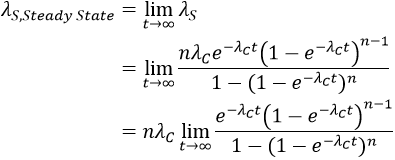Derivations of Failure Rate Equations for Series and Parallel Systems
This article shows the derivations of the system failure rates for series and parallel configurations of constant failure rate components in Lambda Predict.
Series System Failure Rate Equations
Consider a system consisting of n components in series. For this configuration, the system reliability, Rs, is given by:

where R1, R2, ..., Rn are the values of reliability for the n components. If the failure rates of the components are λ1, λ2,..., λn, then the system reliability is:

Therefore, the system reliability can be expressed in terms of the system failure rate, λS, as:

where  and λS is constant. Note that since the component failure rates are constant, the system failure rate is constant as well. In other words, the system failure rate at any mission time is equal to the steady-state failure rate when constant failure rate components are arranged in a series configuration. If the components have identical failure rates, λC, then:
and λS is constant. Note that since the component failure rates are constant, the system failure rate is constant as well. In other words, the system failure rate at any mission time is equal to the steady-state failure rate when constant failure rate components are arranged in a series configuration. If the components have identical failure rates, λC, then:

It should be pointed out that if n blocks with non-constant (i.e., time-dependent) failure rates are arranged in a series configuration, then the system failure rate has a similar equation to the one for constant failure rate blocks arranged in series and is given by:

where λS(t) and λi(t) are functions of time. Please see the HotWire article "Failure Rate of a Series System Using Weibull++" for more details about this equation.
Parallel System Failure Rate Equations
Consider a system with n identical constant failure rate components arranged in a simple parallel configuration. For this case, the system reliability equation is given by:

where RC is the reliability of each component. Substituting the expression for component reliability in terms of the constant component failure rate, λC, yields:

Notice that this equation does not reduce to the form of a simple exponential distribution like for the case of a system of components arranged in series. In other words, the reliability of a system of constant failure rate components arranged in parallel cannot be modeled using a constant system failure rate model.
To find the failure rate of a system of n components in parallel, the relationship between the reliability function, the probability density function and the failure rate is employed. The failure rate is defined as the ratio between the probability density and reliability functions, or:

Because the probability density function can be written in terms of the time derivative of the reliability function, the previous equation becomes:

The reliability of a system of n components in parallel is:

and its time derivative is:

Substituting into the expression for the system failure rate yields:

For constant failure rate components, the system failure rate becomes:

Thus, the failure rate for identical constant failure rate components arranged in parallel is time-dependent. Taking the limit of the system failure rate as t approaches infinity leads to the following expression for the steady-state system failure rate:

Applying L'Hopital's rule one obtains:

So the steady-state failure rate for a system of constant failure rate components in a simple parallel arrangement is the failure rate of a single component. It can be shown that for a k-out-of-n parallel configuration with identical components:
![]()